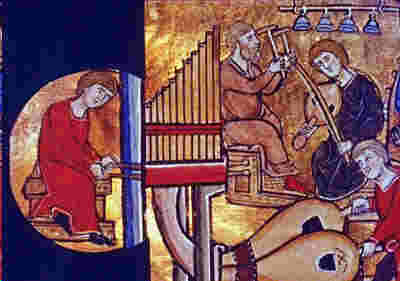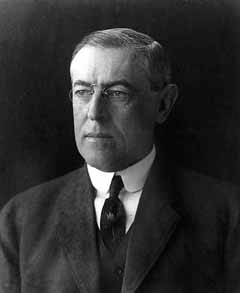
Welcome to music of the first world war Era
On these pages, The Muse Of Music explores Music Of the First World War
Era—pre-war and between-the-wars music of
America and its Allies during the first half of the 20th century. Here The Muse demonstrates that
the music of the First World War Era may be gone, but it is
certainly not forgotten.
About Over there
Of course, what you're hearing is an excerpt from the rousing, Over
There, by George M. Cohan, perhaps the finest and best known song to
come out of the Great War. It was created in a flash of patriotism the
morning after America declared war; Cohan claimed that it practically
composed itself.
 |
| Woodrow Wilson, President of the
United States, who led his nation on "A crusade to make the world safe
for democracy." |
This version This version is a performance recorded in 1917 by Nora Bayes, one of the
original and famous voices of Over There. This very recording stirred
tens of thousands of boys to enlist and boosted the moral of the loved ones
they left behind.
Notice the play for sympathy and support from parents and sweethearts,
and the appeals to the soldier's manhood, religious faith, and national
loyalties. First World War patriotic propaganda manipulated mothers
especially, who ultimately paid a high price for their sons' participation.
In the second verse (not heard), Nora sings the phrase, "For the Sammies
are coming, the Sammies are ...Coming."
The Sammies line is similar to the line, "For the Yanks are
...Coming." in the first verse. Do you know who or what Nora means by
Sammies? Can you guess?
- Reveal the hidden meaning of the word Sammie:
click here.
A major goal of war songs of the era was to gain support from civilians
and participation from soldiers. That Over There succeeded
brilliantly is partly attested by President Wilson's description of
Over There as "a genuine inspiration to all American manhood." Cohan
lived to receive a Congressional Medal from President Roosevelt by special
act of Congress.
Coming—Music of WWI features
In these pages, The Muse demonstrates that music of the First World War
Era may be gone,
but it is certainly not forgotten.
Now journey back in time. Return to the era when the Creeping Barrage and
the gas attack were featured in the daily newspaper, when Roses were in Picardy and reaching over a trench parapet for a flower could trigger a
bullet in the head. Visit one of the features in The Music Of The First
World War Era:
To visit one of the features of The Music Of The First World War Era,
click the name of the feature in the list above.
More Features from Music Of The Second World War Era are on the
way. Check here from time to time to see what's new.
- Read a chronicle of the 1914 Amazing Truce in Sir Arthur Conan
Doyle's Account of the First World War.
- McDermott's Songs.
- McCormack's Roses of Picardy
- In 1946
Flagg published his
autobiography, Roses and Buckshot.
- Books about WWI.
...and more.
about Gone but not forgotten
Gone But Not Forgotten is the place at Electricka's web site where The
Muse Of Music celebrates the bygone eras of so-called "popular" music, music
dating from the first half of the twentieth century, with the emphasis on
music of the Two World Wars and the Big Band Era of the 30's and 40's. The Muse remembers the people who created and played the music and the those who
listened to it live.
The Muse suggests that you visit Gone But Not Forgotten before you
proceed with Music Of The First World war Era. After that, return here and continue your journey to the First
World War era.
When you finish exploring Music Of The First World War Era, continue your
journey back in time. Explore another Gone But Not Forgotten era:
ETAF Recommends
These movies are members of the ETAF-Amazon Collection.
- Roses of Picardy is the name of a silent movie about the war
made in 1927. Visit the Internet Movie Database for details:
click here.
- The song Roses of Picardy was prominently used in the
important, must-see 1987 movie, The Whales of August, a movie about
old age, remembrance, and the end of life which intentionally mixes the
real life situations of some of the actors with situations concocted in
the script. In it, Lillian Gish remembers her sweetheart, who died at the
front in WWI. It was her last movie. Other stars near the end of their
lives: Bette Davis, Vincent Price, Ann Sothern, Harey Carey Jr.
—Page 1,
2,
3,
4,
5—